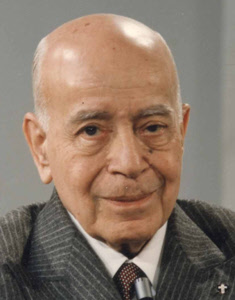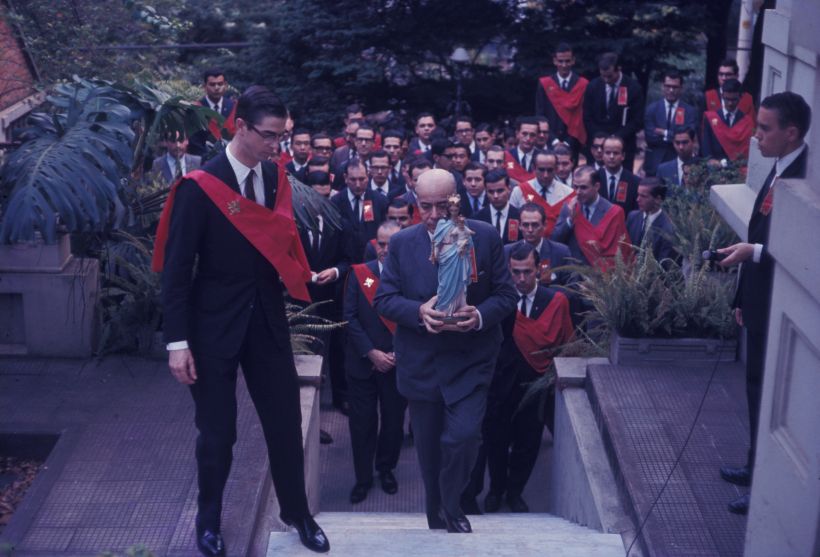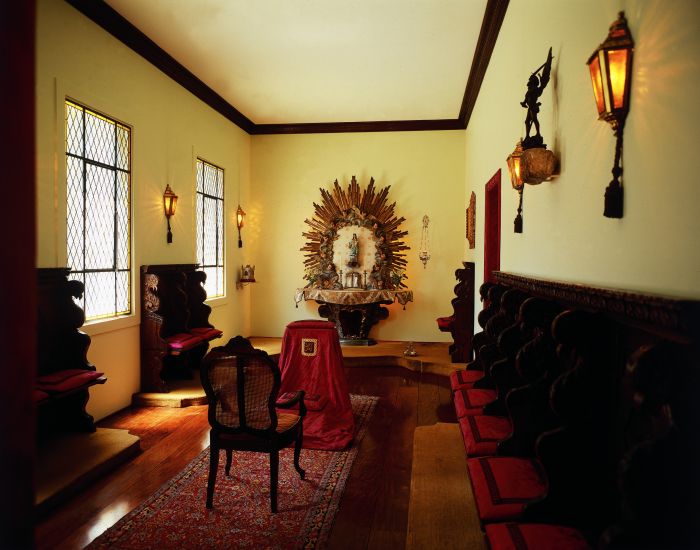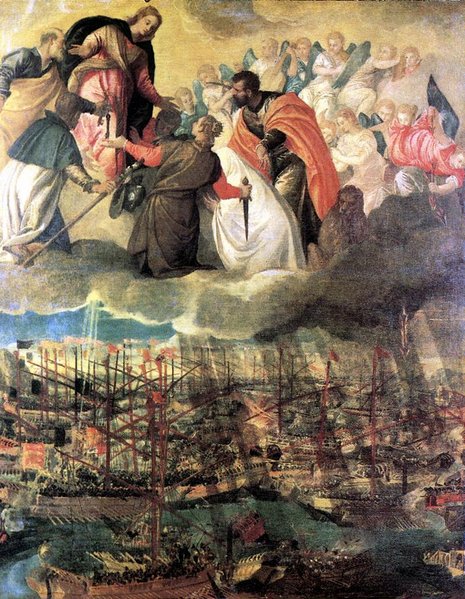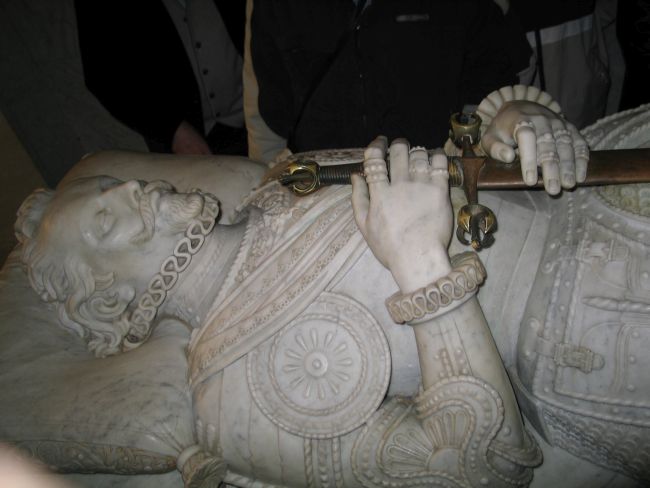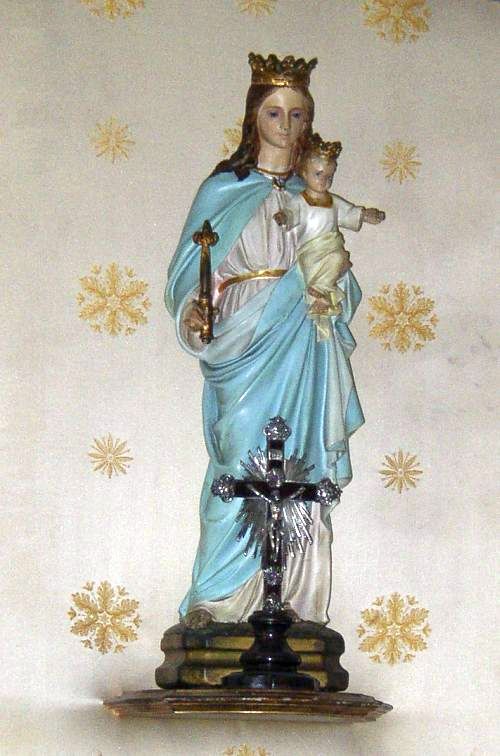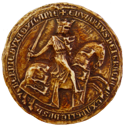|
Plinio Corrêa de Oliveira
Our Insufficiency Proclaims the Victory of Our Lady Help of Christians [2]
"Saint of the Day", Wednesday, May 23, 1984 |
|
|
Audio of the Conference (in Portuguese) The unexpected and magnificent entrance of the statue of Our Lady Help of Christians in this meeting dominates all the other previously narrated facts. For reasons that are well known and felt by all, you have greeted her with a magnificent applause which I believe was the longest ever in this auditorium. It lasted for the whole duration of the Salve Regina chant, and I am sure that if the occasion presented itself, Our Lady Help of Christians would receive even more applause. There are so many reasons for this, which we also know well, that all I can say is that this is a family party. And the impression one has is that a long absent mother has entered the home. And facing that fact, the family members could not sufficiently express their joy, enthusiasm, veneration, respect and hope. “Long absent mother” in what sense? Statues of Our Lady Help of Christians are found in several of our seats. We recently recalled the magnificent stone statue of Our Lady Help of Christians at the entrance of Sao Bento; we also recalled this little statue which has accompanied us from the times of Legionário and Catholic Action. We had this statue at the headquarters of Sao Paulo Catholic Action as we sharpened our arguments to launch In Defense of Catholic Action. I cannot forget the hall on the third floor of the apartment on 176 Quintino Bocaiúva Street at the corner with Benjamin Constant Street where Catholic Action was headquartered, two steps away from my office in the same building. I cannot forget the support base that was there and the statue I bought from an artisan at Rosa e Silva St. and installed with my own hands. Later, when we had to hand over Catholic Action to the adversary, I took her to the Legionário headquarters so that the Queen, having left her throne, would now fight in the trenches. I remember—with how much emotion—that after Legionário was handed over, this statue was taken to our small seat at the ground floor of 669 Martim Francisco street, in a back room of which we had a little oratory where She had her altar. And there we prayed to Her uninterruptedly, until the hour of the reconquest recommenced. Together with to the old and worthy group of Pará street, the Legionário group and the young men of Father Mariaux who joined us, we took up a seat on a 6th floor apartment at Vieira de Carvalho St. And then we took the statue to the chapel at Vieira de Carvalho, where she was placed on a new altar which today you find in the chapel of the Seat of the Reign of Mary. There, the statue was enthroned; numerous Masses were said, holy communions given, in an intense movement of piety until our reconquest took another step. Leaving two comfortable floors in an apartment building, we moved to the small palace on Pará Street. In an evening we took the statue to Pará Street in a car, praying all along the way, and installed it on the same altar that it occupied at Vieira de Carvalho, which we moved to this new chapel.
Solemn enthronement of the image of Our Lady Help of Christians, at the then headquarters of the National Council of the Brazilian TFP, currently headquarters of the Plinio Corrêa de Oliveira Institute. She stayed at the Pará Street seat until she was moved to the largest headquarters our movement has ever had, the seat at Maranhão St. There, she is the object of our continued veneration.
On the altar, the statue of Our Lady Help of Christians Why have I, when speaking of devotion to Our Lady Help of Christians in general, suddenly described the various events and acts of piety performed in the presence of this statue and related in some way to the history of the TFP? I did it to highlight the fact that the profound meaning of our defeats was a diminishing appreciation of the truth and value of devotion to Our Lady throughout Brazil. And also that our reconquest is a reconquest of devotion to Our Lady. Now we have the joy of being able to affirm that all the ground reconquered in Brazil, step by step, has been reconquered for her. “Reconquered for her” is saying little... it has been reconquered by Her! Had she not helped us at every step, had we not turned to her at all times, had we not continuously felt her maternal support, we would have done nothing. And when the TFP reaches its pinnacles and comments and proclaims beautiful campaign results as it did tonight, it should say: these are Our Lady’s deeds in the hinterland of Brazil. What kinds of deeds are they? They are deeds performed above all in our own souls. In other words, the fact that there is an organization like the TFP, with a small number absolutely speaking, but a proportionately huge number of members, volunteers and now a wave of TFP supporters drawing closer to our mentality, customs and style of piety as the whole rages all around us, this is precisely the lily that flourishes in the night, during the storm, rising out of the mud.
Above, an edelweiss, mentioned in the text below. A typical flower of the Alps, it has become a symbol of the mountains Now this lily metaphor means that something entirely unlikely and inexplicable is happening, like an edelweiss sprung in the sands of the Sahara; and therefore, that it was the Mother of mercy, the Mediatrix of all prayers and favors that presented our to her Divine Son of and obtained that it was heeded. What prayer? First of all, the prayer asking her to give us the grace to love her, to belong to her more and more, to confide in her more and more, to bring us ever closer to her, and to deign come ever closer to us. This is the great and fundamental prayer: to have devotion to Our Lady. May Mary make us devotees of her! Someone who could say, “But then, are you relegating to a second place the supreme devotion, which is the worship of Our Lord Jesus Christ? What kind of revolt is this?! Is the cult of dulia replacing that of latria?” I feel like answering: “What kind of stupidity is this!? Our Lady is the necessary channel to reach Our Lord Jesus Christ; she is the only channel to reach Our Lord Jesus Christ. And if we so applaud and venerate Our Lady, is it not because we worship Him to whom She leads? She is the way by which He came to us; it was by her prayers that He became incarnate in her and redeemed the human race. She is the co-Redeemer of the human race; and when He ascended into Heaven, leaving men behind, He left His Mother to alleviate a little the sorrow and immense emptiness caused by His absence. Having all this in mind, if we cling tight to Our Lady we will get to Him. Where shall we go if we do not cling to Our Lady with all the strength of our soul? Down! And we know well who is there. I remember that, when the TFP was in one of its cruelest, more downcast moments in the struggle around In Defense, I had a small hope in Mosca Hermanos, an important publishing house of Montevideo that had written me asking permission to translate In Defense (I agreed). But later on they sent me another letter saying they were no longer interested in publishing the book. Of course, slanders against us had gotten to them. Then I received another letter from Montevideo. I opened it thinking, “What new displeasure will this bring?” It was written in the trembling handwriting of an old man with poor eyesight, who had trouble holding his pen. He was an old Jesuit priest who I had never met. His brief letter read: “However much the TFP is fought [and it was not yet the TFP] – I love and I care a lot about it and thus I give you what I can: first, my prayers, and second, a piece of advice: You are worth what you are worth because you are very devoted to Our Lady; be more and more devout and there is no good that will not happen to you; never diminish this devotion to any degree whatsoever, for then all evil may come upon you.” I folded the letter and thought: this dying old man watered with a little consolation the soul of one who is in the middle of the fight. I want to believe that the pious soul of this true son of St. Ignatius is at the feet of his Founder in heaven, enjoying the beatific vision, and looking at Our Lady. I ask him to pray for us all, that we may follow this advice. Now in order to do this, my dear friends, we must bear in mind a capital point: It is not enough not to diminish one’s devotion to Our Lady; either one increases it every day, or it stops; and what stops, decays. Let us not be afraid to exaggerate as long as we remain faithful to Catholic doctrine in regard to veneration for Our Lady. Let us not be afraid to exaggerate because, “de Mariam nunquam satis,” as St. Bernard said: nothing is ever enough when it comes to Our Lady: more, more, more and more! She will know how to reward. Our Lady Help of Christians! Why this title, Help of Christians? Is Our Lady’s greatest title of glory to be a helper? Isn’t being the Mother of God her greatest glory? Of course! Isn’t her greatest glory to be co-Redemptrix of mankind? Of course! Isn’t her greatest glory to have been conceived without original sin? Of course! Why then is she called Our Lady Help of Christians? Why so much insistence on this invocation? This is understandable because since she is the Mother of Our Lord Jesus Christ and Our Mother, She is permanently willing to help us in all our needs. Saint Louis Marie Grignion de Montfort has an expression that seems exaggerated but is absolutely within the truth. He says that if there was in the world a single mother gathering in her heart all the forms and degrees of tenderness that all the world’s mothers would have for a single child, and if that mother had only one child to love, she would love him less than Our Lady loves each and every man. So She is the Mother of each of us to such a degree and loves us so dearly, however helpless, misguided or spiritually lame we may be, that her first movement when anyone turns to her is one of love and readiness to help. She accompanies us even before we turn to her. She is aware of what happens to all men, everywhere. She sees us here talking about her, and I dare hope that by the intercession of our angels in heaven She smiles as she sees us speak about her and sees the cheers and applause breaking out in this room. She knows our needs. And it is through her intercession that we have the grace to turn to her. It is she who asks God that we have this grace. He gives us this grace, and we turn to her. We turn to her, and her first question is, “My son, what do you want?” I have seen a statement that was not by a great theologian but I have the impression that it is true: that if Judas Iscariot himself, after having sold Our Lord and on his way to the cursed place where he hanged himself, had had a moment of devotion to her and prayed to her, she would have helped him. Had he looked for her and said, “I am not worthy to come near to you, I am not worthy of looking at you, I am not worthy to address you. I am Judas, the unclean...but you are my Mother, have pity on me!” She would have kindly received that man, that son whose name is synonymous with the lowest and most disgusting torpidity to the point that no one utters it without extreme disgust: Judas Iscariot... even him! But we find it difficult to keep this in mind. Why? Because we do not see, and in our misery, we often are among those who do not believe because they do not see. We do not doubt but we forget...we feel so far removed, so displaced that we say: “But is this really so? This has happened to me, that happened to me, the other thing happened to me...I asked her and was not helped; why should I believe that I am going to be rescued now? Mother of Mercy...at times for some, sometimes for me...but sometimes not...how do I know that I will be helped in this coming ordeal? O Mother of Mercy!” It is in such moments, more than ever, that we must say: Auxilium Christianorum, ora pro nobis! In the moments when we do not understand, have no idea what the way out of the situation will be, that we must repeat with insistence: Auxilium Christianorum! Auxilium Christianorum! Auxilium Christianorum! Every situation has a way out. Sometimes we do not see the solution she gave, but she is giving the problem a monumental way out. And when I remember the history of our catastrophes, the story of our recoveries, the story of our painful and glorious “dead-end street” I turn back and wonder: if She allowed me to choose between this dead-end street or any other route I imagined, which would I have preferred? I would have replied: “My Mother, if You give me strength, I choose the dead end street!” Street of the inexplicable, street of seeming catastrophe, defeat, destruction…and of ultimate victory! How beautiful is the dead-end street! Why? because it is Our Lady’s triumphal avenue. She opens up the dead ends! She is the one who turns this monstrous dead end street into an open avenue. And so we understand how her providence works: it is a true marvel. Therefore, for this very special reason, we must always repeat: Auxilium Christianorum! We are so few, so persecuted, so isolated, often so inwardly tried, there is so much that goes on within and around us; we feel so much the adversary that roars from all sorts of distances! How could we not always say: Auxilium Christianorum! Auxilium Christianorum? We are few to make it clear that the victory was Hers! Our insufficiency proclaims her victory and sings her glory! How can we not be enthused by the idea that She made us so few that She might be so greatly glorified? Obviously!
The Battle of Lepanto, painting by Paolo Veronese (16th century) The upshot is that this prayer should be on our lips at all times: Auxilium Christianorum, ora pro nobis; Auxilium Christianorum, ora pro nobis! You have an example of this in the battle of Lepanto, so closely linked to today’s feast. [1] This is what happened in the battle of Lepanto: The Catholic fleet was enormously disproportionate to the Mohammedan fleet. That was already something hard to understand: Would it not be more understandable that Our Lady had assembled a potent, magnificent Catholic fleet to crush those impious followers of Mohamed? Why did she not do it? No. It was a small, one could almost say, rickety fleet. The Muslim fleet arrives, forms a half moon and encircles the Catholics. The battle begins. During the battle, the Catholics sustain several setbacks. At one point, Catholics jump onto the enemy flagship and start attacking! They have some successes, the Mohammedan fleet escapes. The Muslims themselves do not understand well why they are fleeing ... But in chronicles found by the Mohammedans themselves, it is written: The fleet fled because a terrible Lady appeared in the sky and stared at them with such a menacing gaze that they fled. Was it not a good thing that the Catholics were so few? Was it not good for them to face so many risks? Was it not good for them to fight like heroes in a more or less desperate situation, as the enemy was way too strong? But they never stopped confiding in Our Lady and the result is that she appeared and chased the Muslims away. There is nothing more beautiful! Now let us turn our glances away from Lepanto and toward the splendors of the Vatican. In a room of the Vatican, a holy pope - St. Pius V - presides a meeting of cardinals. But the main focus of his attention is on that fleet which, with great diplomatic difficulty, he had managed to assemble. The bulk of the fleet was made up by Spanish ships which King Philip II had taken too long to send over. Then there were a few ships from the Serene Republic of Venice, and a paltry number of small vessels of the Holy See. The fleet was under the command of Dom John of Austria. The ships of the Holy See were under the command of Prince Colonna. The Pope kept all that in his thoughts. At one point, without any explanation, the Pope moves away from the meeting of cardinals, leans on a window sill and is seen with a rosary in his hands. He prays the whole chaplet, returns and says: “A great victory has been won by Dom John; the Christian fleet is victorious, the war has been won!” Dom John of Austria fought very hard, he was a great warrior, a hero. In his grave at the Escorial, which I had the joy of visiting, his epitaph is a phrase by St. Pius V about him: “Fuit homo missus a Deo cujus nomen erat Joannes” – There was a man sent by God, whose name was John,” precisely what the Gospel says of St. John the Baptist, applied to Dom John of Austria.
Tomb of Dom John of Austria in the Palace of Escorial (Spain) But who was the man who obtained from the Queen of Heaven to descend into the battle and defeat the enemy with her gaze? It was St. Pius V, who prayed the Rosary to Our Lady, Auxilium Christianorum! So, my dear friends, let us pray Auxilium Christianorum! Auxilium Christianorum! Auxilium Christianorum! in all circumstances of our life, so that when our life is about to end and we are to breath our last we may still say Auxilium Christianorum and heaven will soon open up for us! Now let me close with some “Ambiences and Customs” type comments on this statue of Our Lady Help of Christians here in the Seat of the Reign of Mary.
At that time our financial conditions only allowed us to buy a regular, commercially priced statue, and so this statue is not a work of art. It is a plaster statue made in series and found everywhere, of a religious style called Sulpician, which is well known and I will not describe for you here. Why did I buy this statue? First, because I only had so much money. I bought it with my own money. This image is my private property. I did not give it to Catholic Action, to my dear TFP, or to my dear Legionário. I did not give it to anyone. And it is likely inscribed in the TFP records as a statue belonging to me. I even remember that, when I bought the statue I pasted on its base a business card in which I wrote, “private property of Plinio Corrêa de Oliveira” so that if anyone ever disputed its property I could say, “Look here how old this paint is, this statue has been mine since that time!” I will say more, you will be amazed at the price I paid for the statue: twenty-five cruzeiros! I remember to this day ... you can’t buy anything for twenty five cruzeiros ... The cruzeiro is an entity of reason; I think it has disappeared... Why did I consider this statue a real find? And why did I buy it after a little hesitation? I found that the statue’s physiognomy expresses an inner serenity entirely arising from temperance. Temperance is that cardinal virtue by which one has for each thing the degree of attachment or repudiation proportional to it. In this way, one is entirely adequate and proportional to all circumstances and situations, and one never detests anything in exaggeration or love something less than it deserves; and one never detests anything less than it deserves. Having entire execration for entirely execrable things is part of the virtue of temperance. To me this statue seemed to shine very much with this disposition of soul. Albeit discreetly, she is so calm and such a mistress of herself, so ready to take action in face of anything, in an entirely proportional way; she is so detached from herself that to me she seemed the very symbol of balance, which is the corollary of the virtue of temperance. Accordingly, she has something virginal and pure that enchanted me, and at the same something maternal in that she seems to be looking at a son, smiling and ready to maneuver and use her scepter as a decisive Queen to heed his request. Indeed the true symbolism of Help of Christians is Our Lady with the Crown. An open crown, because a closed crown belongs to a King; in the presence of the King no one wears a closed crown, and she has the Baby Jesus in her arm. Is his crown open? (It is) It should be closed. He is on her arm, his arms open, smiling. You see that she asked and He smiled; and that his open arms are a result of her prayer and that she seems pleased to see how her poor son kneeling there is delighted to see her Son par excellence smile and spread his arms. She is help; she is the one who obtains for us from Him, the author and ultimate source of all graces, all that we ask for. At the same time, she seemed very regal but very simple, all of it in such a way that I was enormously pleased with the overall expression of the statue. The only thing I didn’t quite like was its color. Why? because the blue is too faded, and the pink is too light. I am a friend of sharp colors, although I admit that in this case, too lively a color would be in contradiction with that serenity of temperance that shines in her. But to me it would seem that it should be a sharper, more defined color. I asked myself, “How can I have this colored?” I could not afford to have the statue repainted at the time. So I said, let us leave it as it is. If nobody notices, I will not say anything. As I recall, this is the first time that I am commenting on this defect of the statue. But after she spent so many years with us, why would we paint it now? It would not be fitting. She should remain as she came. NOTES [1] The battle of Lepanto took place on October 7, 1571, and the Catholic victory was due to devotion to the Rosary, led by the Pope of the time, St. Pius V, who added the invocation Auxilium Christianorum to the Litany of Our Lady in recognition for the victory. In turn, the feast of Our Lady Help of Christians was introduced in the liturgical calendar by decree of Pope Pius VII in 1814 in recognition for his liberation and happy return to Rome after a long and painful captivity in the hands of Napoleon Bonaparte. [2] The preceding article is taken from an informal lecture Professor Plinio Corrêa de Oliveira gave on May 23, 1984. It has been translated and adapted for publication without his revision. |
|
